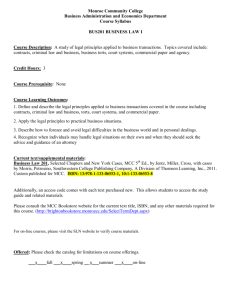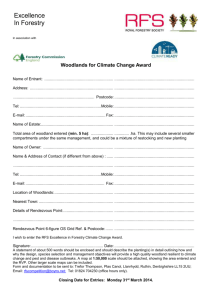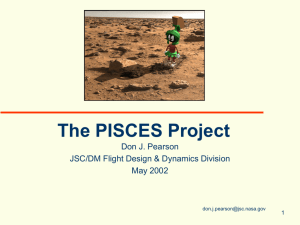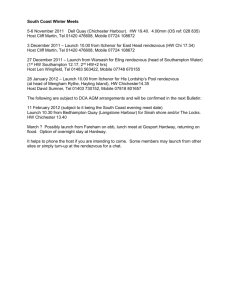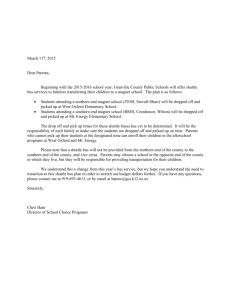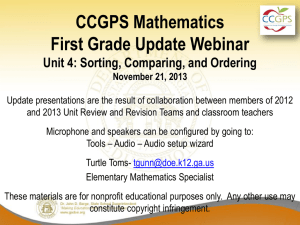doc - James Oberg
advertisement
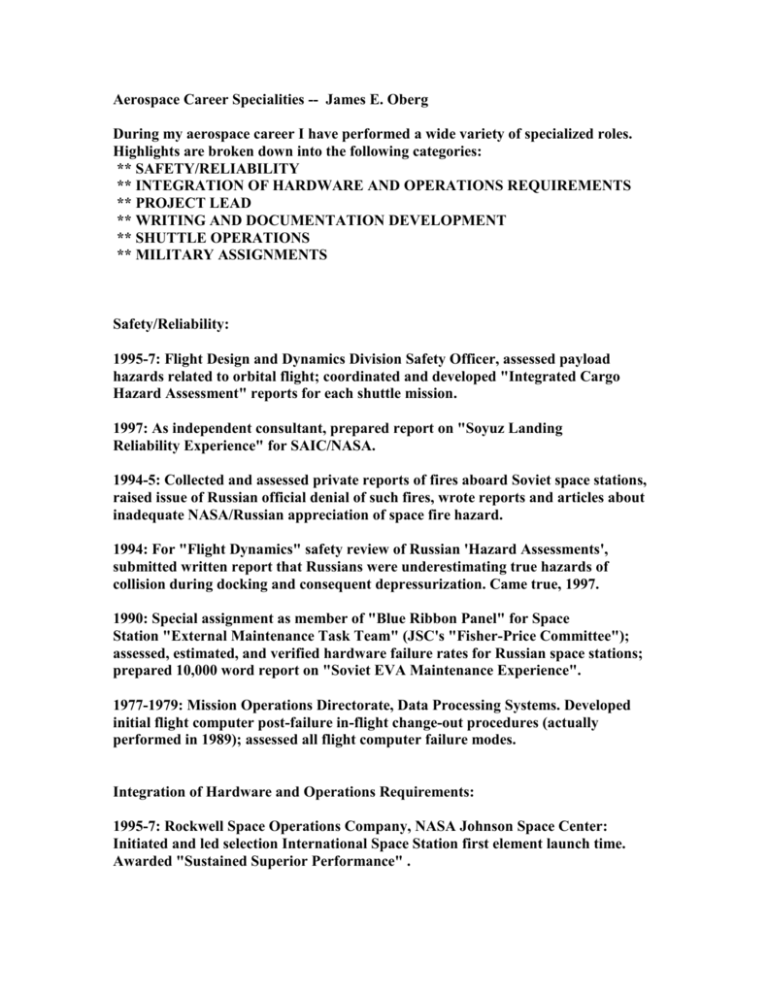
Aerospace Career Specialities -- James E. Oberg During my aerospace career I have performed a wide variety of specialized roles. Highlights are broken down into the following categories: ** SAFETY/RELIABILITY ** INTEGRATION OF HARDWARE AND OPERATIONS REQUIREMENTS ** PROJECT LEAD ** WRITING AND DOCUMENTATION DEVELOPMENT ** SHUTTLE OPERATIONS ** MILITARY ASSIGNMENTS Safety/Reliability: 1995-7: Flight Design and Dynamics Division Safety Officer, assessed payload hazards related to orbital flight; coordinated and developed "Integrated Cargo Hazard Assessment" reports for each shuttle mission. 1997: As independent consultant, prepared report on "Soyuz Landing Reliability Experience" for SAIC/NASA. 1994-5: Collected and assessed private reports of fires aboard Soviet space stations, raised issue of Russian official denial of such fires, wrote reports and articles about inadequate NASA/Russian appreciation of space fire hazard. 1994: For "Flight Dynamics" safety review of Russian 'Hazard Assessments', submitted written report that Russians were underestimating true hazards of collision during docking and consequent depressurization. Came true, 1997. 1990: Special assignment as member of "Blue Ribbon Panel" for Space Station "External Maintenance Task Team" (JSC's "Fisher-Price Committee"); assessed, estimated, and verified hardware failure rates for Russian space stations; prepared 10,000 word report on "Soviet EVA Maintenance Experience". 1977-1979: Mission Operations Directorate, Data Processing Systems. Developed initial flight computer post-failure in-flight change-out procedures (actually performed in 1989); assessed all flight computer failure modes. Integration of Hardware and Operations Requirements: 1995-7: Rockwell Space Operations Company, NASA Johnson Space Center: Initiated and led selection International Space Station first element launch time. Awarded "Sustained Superior Performance" . 1992-1994: Shuttle/Station Integration for orbital design: match undefined Space Station operational requirements to changing Space Shuttle capabilities, identify mismatches and develop reconciliation strategies; assess correctness and completeness of baseline procedural documentation; pioneer planning and training for Space Station control center trajectory operations. Perform same analysis for space shuttle science payloads and subsatellites. Project Lead: 1995-7: Orbit design leader for STS-88, first Space Station mission (July 1998). 1990-1991: Mission Control Center support of shuttle flights STS-37 (GRO Deploy plus rendezvous navigation exercise) as lead MCC planning shift Rendezvous Guidance and Procedures Officer, and STS-39 (multiple deploys and retrieve with a USAF payload) as Mission Support Room chief. Planning shift leader for STS-48 UARS mission. Multi-discipline team lead, "Ku-band radar" in-flight anomaly analysis and resolution strategy development effort. 1987-1990: Lead "Book Manager" and Lead MCC Rendezvous Officer for the LDEF Satellite Retrieve Mission, STS-32. On console (in the "Trench") for actual mission as MCC senior operator responsible for rendezvous. 1986-1988: Lead analyst for combination of Mission Control Center jobs of "rendezvous procedures officer" with "GUIDO" (guidance officer), became first controller certified for the new position. 1981-1983: Led "Crew Flight Procedures" team for "Proximity Operations and Rendezvous" as McDonnell Douglas Astronautics Company Task Manager. Selected "1984 Technical Person of the Year" for rendezvous work. Writing and Documentation Development: Apart from official duties, published ten books and a thousand magazine and encyclopedia articles on topics in the past, present and future of space activity around the world. Lectured to conferences, testified before Congress. 1993: NASA seminar on "Shuttle/Station Separation Techniques", developed documentation, background data & procedures rationale references, wrote and published 200-page conference proceedings. 1990-1991: Developed detailed training/verification plan (200 pages) for MCC job of "Rendezvous Guidance and Procedures Officer", including all lesson plans, simulator exercises, oral examinations, certification requirements. 1990-1994: Located, collected, selected & annotated documents for "History of Orbital Rendezvous" reference book and training manual, 400 pages. 1986-1991: Mission Operations Division, Orbital Rendezvous Procedures team. Wrote flight crew procedures handbook (400 pages), identified by MCC Director as "a model for others to follow". Wrote MCC console handbook (300 pages) for entire rendezvous guidance and procedures MCC team. 1984-1985: McDonnell Douglas Astronautics Corporation employee, team for contract bid development on USAF "SOPC" (to be the DoD's own Space Shuttle operations center). Ground up assessment of "ideal" future mission control organization. MDAC won the SOPC contract but USAF then canceled project. 1983-1984: MDAC Proposal Team for Space Transportation System Operations Contract, studied NASA-JSC's "Mission Operations Division", collected and appraised all Mission Control Center console reference handbooks, prepared "white paper" on Systems Division functions, plus documentation of mission preparation process flow. Rockwell won the contract anyway in 1985. 1978-1979: Space Shuttle Flight Techniques Panel, first executive secretary; inaugurated NASA-JSC procedures for "flight rules" documentation, still used. 1977-1979: Mission Operations Directorate, Data Processing Systems. Prepared Shuttle Systems Handbook drawings for on-board General Purpose Computer (used for next twelve years). 1975-7: USAF Captain, detailed to NASA-JSC Software Division, Houston, wrote requirements documents for shuttle's flight software & Spacelab computers. Shuttle Operations: 1990-1991: Mission Control Center support of shuttle flights STS-37 (GRO Deploy plus rendezvous navigation exercise) as lead MCC orbit planning shift Rendezvous Guidance and Procedures Officer, and STS-39 (multiple deploys and retrieve with a USAF payload) as Mission Support Room chief. Orbit planning shift leader for STS-48 UARS mission. 1987-1990: Lead MCC Rendezvous Officer for the Long Duration Exposure Facility (LDEF) Satellite Retrieve Mission, STS-32. On console (in the "Trench") for actual mission as MCC senior operator responsible for rendezvous. 1988: During support of DoD mission STS-27, led effort to resolve missionthreatening navigation anomaly and traced it to documentation/crew error. 1983-4: Real time mission support to STS-6 and STS-7 for first release and retrieval of free-flying satellites. 1979-1981: McDonnell Douglas Technical Services Corporation employee in NASAJSC Mission Control Center, supporting the Space Shuttle's on-board propulsion systems (OMS/RCS, or Orbital Maneuvering System and Reaction Control System). Supported STS-1 launch on console in MCC as the "Prop Consumables" officer; supported STS-2 as "Prop Consumables" planning lead. Military Assignments: 1972-1975: Faculty of Department of Defense Computer Institute (DODCI), Navy Yard, Washington DC. Instructor and consultant on computer-based management information systems and computer systems security. Helped design/test "Arpanet", ancestor of today's "Internet". 1970-1972: Battle Environments Branch, Air Force Weapons Laboratory, Kirtland AFB, New Mexico. Assessed airborne laser weapons performance using math modeling and computer simulation of aerodynamic, laser, and nuclear effects. Security Officer. Avoidance scheduling for USSR reccesats. 1966-69: Distinguished Military Graduate, AFROTC; received NASA Traineeship for graduate study at Northwestern University while on 'educational delay'.
